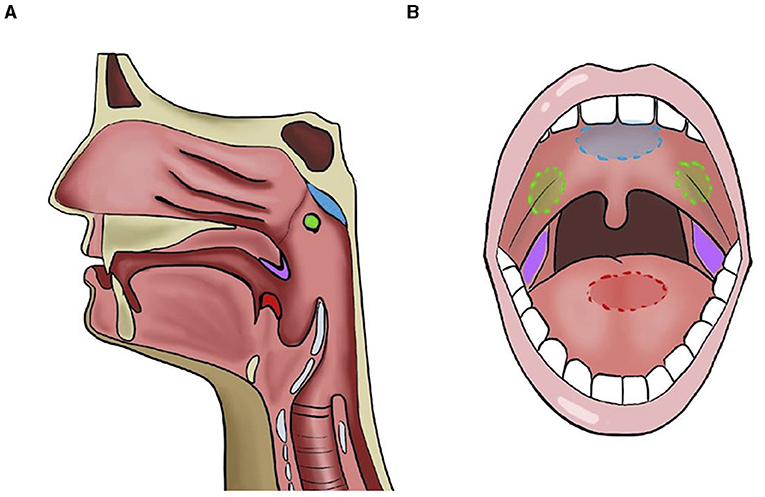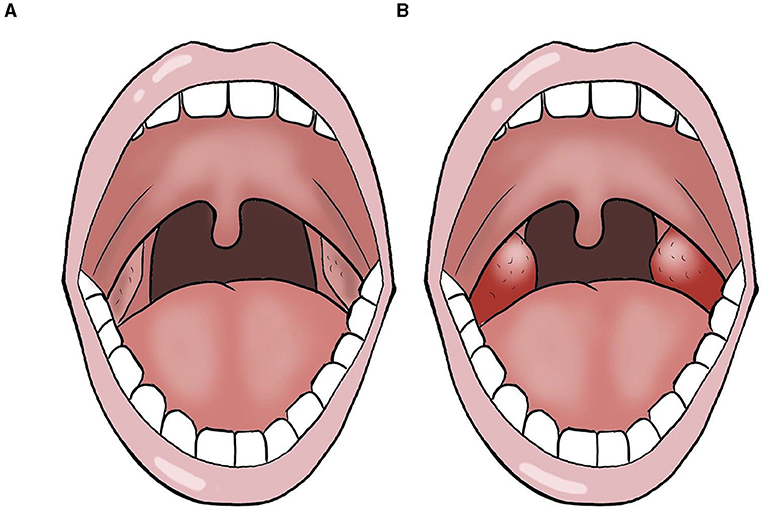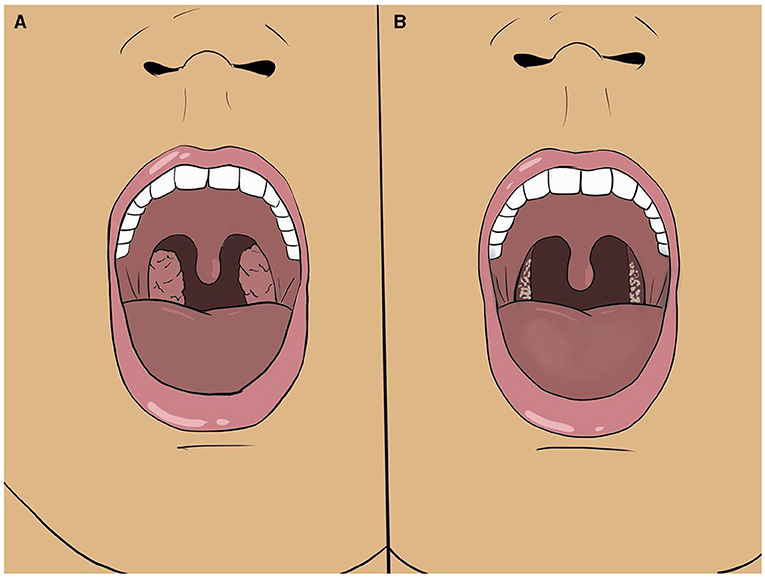Abstract
Tonsils are an essential part of the immune system. The tonsils are made of lymphatic tissue, which contains white blood cells to help us fight infections caused by germs. Tonsillitis occurs when the tonsils become infected by germs, making them red, swollen, and painful. For individuals with frequent tonsillitis or large tonsils that cause nighttime breathing difficulties, a surgical procedure to remove the tonsils, called a tonsillectomy, may be recommended. This surgery usually takes 30–60 min and can prevent future tonsil infections or nighttime breathing problems. Tonsillectomy surgery is one of the most common surgeries performed in children and most people have a successful recovery. These recoveries are made better by being able to eat soft foods like ice cream!
What are Tonsils and Where are They Found?
When people talk about tonsils, they are usually talking about the two structures at the back of the throat, called the palatine tonsils. You can see these when you open your mouth wide and look in the mirror. They are on either side of your uvula, which is the structure hanging down in the middle. The tonsils are made of lymphatic tissue, which consists of white blood cells that fight germs to keep us healthy [1]. Did you know that people have two other tonsils? The lingual tonsil is found at the back of the tongue, and the adenoids are a bit higher up in the throat, where we cannot see them. All four tonsils form a ring-like shield, called Waldeyer’s ring (Figure 1) [2]. Tonsils are important as they are one part of the immune system’s first line of defense against germs that we may inhale or ingest.

- Figure 1 - Waldeyer’s ring (A) from the side and (B) from the front, showing the palatine tonsils in purple, the adenoids in blue, and the lingual tonsil in red.
What Happens When Germs Infect the Tonsils?
Sometimes, when germs overwhelm the immune system, the palatine tonsils can become infected. This is called tonsillitis (Figure 2). These germs can be viruses (which is most common), or bacteria. When someone becomes sick with tonsillitis, they usually have a fever, sore throat, and swollen and painful lymph nodes. Lymph nodes are small bean-shaped structures found throughout the body. As part of the immune system, lymph nodes contain cells that help the body fight germs and prevent infection and disease. If you have ever had a doctor feel your neck, they were probably trying to see if you had enlarged lymph nodes. When you have tonsillitis, a doctor might give you a medicine called an antibiotic, which fights against bacterial infections.

- Figure 2 - (A) A front view of healthy, normal palatine tonsils located on either side of the throat.
- (B) Red, swollen, and enlarged palatine tonsils with tonsillitis.
Why Might Someone Get Their Tonsils Removed?
The two most common reasons why someone may need to have their tonsils removed are nighttime breathing difficulty and repeated tonsil infections. If the tonsils are too large, they can narrow the throat, making it harder to breathe. This becomes more obvious at nighttime when people sleep, and is called sleep-disordered breathing [3]. Some people may not realize they have sleep-disordered breathing until their parents notice that they snore, have pauses in their breathing, or have restless sleep. Some kids may notice on their own that they have trouble paying attention at school because they are tired from not sleeping well [3]. Sleep-disordered breathing over many years can cause long-term issues with the heart and lungs, since these organs have to work harder to make sure all the cells in the body are receiving enough oxygen. To prevent these problems, children with sleep-disordered breathing are often recommended to have their tonsils removed.
Individuals who have many episodes of tonsilitis may also need to have their tonsils removed. Tonsils are usually removed if someone has tonsillitis seven times in the past year, five times per year for each of the last 2 years, or three times per year for each of the last 3 years [4].
How are Tonsils Removed?
Tonsils are removed by a surgery called a tonsillectomy. Tonsillectomies are one of the most common surgeries in children. There are over 500,000 tonsillectomies performed each year in the United States for children <15 years of age. A surgeon who specializes in the ears, nose, and throat—called an ENT (for ears, nose, and throat) specialist, or an otolaryngologist–head and neck surgeon, performs the procedure. These surgeons work with nurses and other doctors, such as anesthesiologists. Before the surgery, the anesthesiologist puts the patient to sleep with a plastic mask placed over the patient’s nose and mouth, which delivers medicine.
The surgeon will then remove the palatine tonsils and will likely also remove the adenoids. The tonsils can be removed with their outer lining, called a capsule, or the surgeons may leave the capsule alone. Think about an orange with its peel on the outside. The inside of the orange is soft and is like the tonsil, whereas the peel is strong and tough just like the capsule around the tonsil. The surgeons are very careful when removing the tonsils because the tonsils sit on top of muscles in the throat. It is also important for the surgeon to stop any bleeding during the surgery [3].
After the surgery, patients are moved to a recovery room and may feel sleepy for a few hours. Patients may be able to go home that day or may need to stay overnight in the hospital. After a tonsillectomy, it is common to have a sore throat, sore ears, and patients’ voices may sound a little different. Luckily, the throat tends to heal quickly, and these symptoms usually go away after a couple of weeks. After surgery, the back of the throat will have a yellow-white coating on it, like a scab you get after a cut (Figure 3). To protect this white coating, patients must be careful about what they eat and need to stick to soft foods like ice cream, pudding, yogurt, scrambled eggs, and mashed potatoes. Patients should avoid eating any hot foods or hard, scratchy foods like potato chips. Tonsillectomies are one of the safest surgeries, and most children heal well after their surgery without any problems [5]. And do not worry, even after the tonsils are removed, the body still has lots of ways of fighting germs!

- Figure 3 - (A) Tonsillectomy surgery involves the removal of the palatine tonsils.
- (B) The healing process following tonsillectomy surgery. Initially, the area may be red, but after a few days it will have a yellow-white coating on it, like a scab you get after a cut.
What Does This All Mean?
The tonsils play an important role in fighting germs and keeping us healthy. However, for some people, the palatine tonsils can cause trouble—whether it be from sleep-disordered breathing or frequent episodes of tonsillitis. As a result, it is often better for these people to have their tonsils removed in a procedure called a tonsillectomy. Tonsillectomy surgery is common, and recovery is made much better with lots of ice cream!
Glossary
Palatine Tonsils: ↑ Lymphatic tissue containing white blood cells, located on each side of the back of the throat.
Lymphatic Tissue: ↑ Specialized cells and organs, including the lymph nodes, that help make up part of the immune system to fight germs and promote healing.
Lingual Tonsils: ↑ Lymphatic tissue containing white blood cells, located at the back of the tongue in the form of little bumps.
Waldeyer’s Ring: ↑ The ring of lymphatic tissue at the back of the throat, made up of the palatine tonsils, the lingual tonsil, and the adenoids.
Immune System: ↑ Components of the body, including cells and organs, that protect the body from things like germs and help the body heal when sick or hurt.
Tonsillitis: ↑ An infection of the tonsils that causes swelling, fever, sore throat, and trouble swallowing.
Tonsillectomy: ↑ A surgery in which the palatine tonsils at the back of the throat are removed by a specialized surgeon.
Otolaryngologist–Head and Neck Surgeon: ↑ A surgeon who specializes in treating disorders of the ears, nose, throat, head, neck, and airway. One of the surgeries they perform is tonsillectomy.
Conflict of Interest
The authors declare that the research was conducted in the absence of any commercial or financial relationships that could be construed as a potential conflict of interest.
References
[1] ↑ Santhosh, S. 2022. The Tonsils (Waldeyer’s Ring). TeachMeAnatomy. Available at: https://teachmeanatomy.info/neck/misc/tonsils-and-adenoids/ (accessed March 5, 2024).
[2] ↑ Meegalla, N., and Downs, B. W. 2023. Anatomy, Head and Neck, Palatine Tonsil (Faucial Tonsils). National Library of Medicine National Center for Biotechnology Information. Available at: https://www.ncbi.nlm.nih.gov/books/NBK538296/ (accessed March 5, 2024).
[3] ↑ Bohr, C., and Shermetaro, C. 2023. Tonsillectomy and Adenoidectomy. Nih.gov. StatPearls Publishing. Available at: https://www.ncbi.nlm.nih.gov/books/NBK536942/?fbclid=IwAR0Q0eNi0epjbR_NmsP4l3-UOpIf1PJGbl9OVRkF1BhVIAv7ItUGOBYFvoc (accessed March 5, 2024).
[4] ↑ Wilkes, J. 2019. Tonsillectomy in children: AAO-HNS updates guideline. Am. Fam. Phys. 100:316–317. doi: 10.1177/0194599818807917
[5] ↑ MyHealth Alberta. Tonsillectomy: What to Expect at Home. Available at: https://myhealth.alberta.ca/Health/aftercareinformation/pages/conditions.aspx?hwid=ud2585#:~:text=Avoid%20hot%20drinks%2C%20soda%20pop,scrambled%20eggs%2C%20and%20mashed%20potatoes (accessed March 5, 2024).
